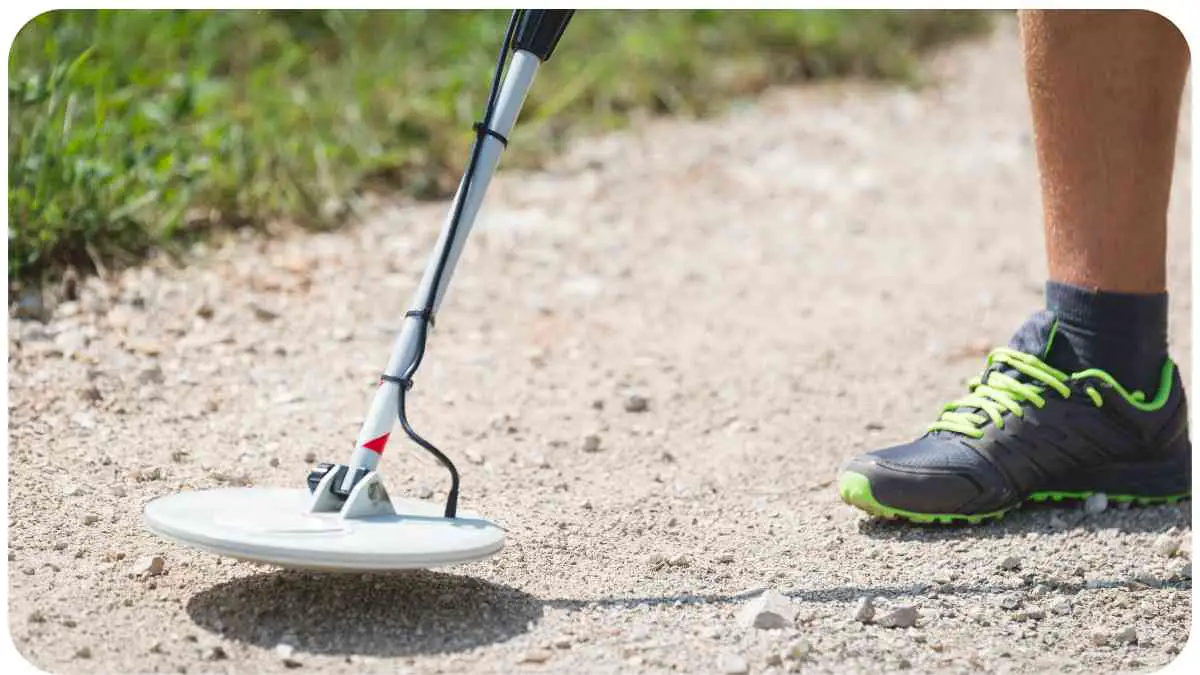Welcome to our comprehensive guide on understanding your metal detector’s signals. As a seasoned metal detecting enthusiast, I intend to share valuable insights, tips, and tricks that will enhance your metal detecting journey.
By deciphering the signals produced by your metal detector, you’ll be able to identify different types of metals and objects hidden beneath the surface.
Join me as we explore the intricacies of metal detector signals and learn how to extract the most from your detecting experience.
| Takeaways from the Blog |
|---|
| Metal detecting requires knowledge of discrimination patterns and target interpretation. |
| Understanding audio and visual signals on your metal detector is crucial for effective detection. |
| Adjusting settings such as ground balance, sensitivity, and threshold can optimize detection performance. |
| Recognizing and managing common signal interferences can improve detecting efficiency. |
| Conducting thorough research and planning, as well as employing systematic search techniques, can enhance success rate. |
| Regular maintenance and proper care of your metal detector help ensure longevity and optimal performance. |
How Metal Detectors Work
To understand metal detector signals effectively, it’s essential to grasp the underlying technology. Metal detectors operate by generating a magnetic field and analyzing the disruption caused when metal objects interact with this field. The detectors consist of a control box, search coil, and shaft, all playing crucial roles in signal detection.
When it comes to mastering the art of treasure hunting, it’s crucial to have a deep understanding of your equipment. For those who wish to elevate their skills, the article on maximizing your metal detecting skills offers a trove of expert tips and tricks.
Types of Metal Detector Signals
Metal detectors employ various methods to communicate with users, including discrimination and target ID, audio signals, visual signals, and depth indication. Let’s delve into each of these signal types and comprehend their significance within the detecting process.
Discrimination and Target ID
Discrimination allows you to differentiate between various metals based on their conductivity and magnetic properties. Target ID provides additional information about the type of metal detected, often displayed as a numerical range or visual scale on the control panel. Refer to Table 1 below for a comprehensive list of common metals and their corresponding Target ID values.
| Metal | Target ID Range |
| Aluminum | 50-60 |
| Brass | 70-80 |
| Copper | 80-90 |
| Gold | 90-95 |
| Iron | 0-20 |
| Silver | 70-85 |
| Zinc | 40-50 |
Table 1: Common Metals and Target ID Ranges
Audio Signals

Audio signals emitted by metal detectors are of paramount importance. They provide crucial feedback about the presence, depth, and quality of the detected targets. When interpreting audio signals, it’s essential to train your ear to distinguish between different tones and pitches.
By referring to Table 2, you can cultivate an understanding of the audio signals’ characteristics and correspondences.
| Signal | Tone | Target Interpretation |
| High Tone | Clear and Sharp | High-value metals (e.g., silver, gold) |
| Low Tone | Dull and Indistinct | Ferrous metals (e.g., iron, steel) |
| Mixed Tones | Fluctuating | Presence of multiple target types |
| No Signal | Absence of Tone | Absence of metallic target |
Table 2: Audio Signals and Target Interpretation
Visual Signals
In addition to audio signals, modern metal detectors often utilize visual indicators to enhance user experience and signal comprehension. These visual displays may include target identification icons, depth indicators, and signal strength meters.
By referring to these visuals, detectorists can gather valuable information without solely relying on audio signals.
Depth Indication
Metal detectors often provide an estimation of the target’s depth, allowing detectorists to evaluate the effort required for excavation accurately. Understanding the depth indication and how it corresponds to your specific detector model is crucial for efficient target recovery.
Diving into the world of metal detecting can be both exciting and overwhelming. Beginners looking to get a strong foundation in the hobby should consider reading the guide on how to get started with metal detecting for essential insights.
Interpreting and Analyzing Signals
Now that we have explored the different types of metal detector signals, let’s delve into the process of interpreting and analyzing these signals. By understanding the patterns and characteristics of the signals, you can improve your target identification skills and maximize your metal detecting success.
Understanding Discrimination Patterns
Discrimination patterns play a vital role in metal detecting. By adjusting the discrimination settings on your detector, you can selectively accept or reject certain types of metals. For example, if you’re specifically searching for valuable coins, you can adjust the discrimination to ignore signals from iron or aluminum.
However, it’s crucial to strike a balance, as overly high discrimination levels might exclude valuable targets. Experiment with different discrimination settings and refer to Table 3 to understand the common discrimination patterns for various types of targets.
| Discrimination Pattern | Target Interpretation |
| Low Discrimination | Detects all types of metals, including iron and low-value items |
| Medium Discrimination | Filters out iron and some low-value metals |
| High Discrimination | Filters out most ferrous metals, ideal for coin hunting |
| Notch Discrimination | Customize discrimination by targeting specific ID ranges |
Table 3: Discrimination Patterns and Target Interpretation
Differentiating Targets
To become proficient in metal detecting, it’s crucial to differentiate between targets accurately. By learning how different metals react to your detector’s signals, you can develop an intuitive understanding of the objects you’re detecting.
For instance, gold and aluminum may produce similar ID values, but gold tends to give stronger audio signals and exhibits different conductivity characteristics. Familiarize yourself with Table 4 to aid in distinguishing between various target types.
Achieving success in metal detecting isn’t just about swinging your detector around. To ensure fruitful searches, take a moment to peruse these 10 essential tips for successful metal detecting that can make all the difference.
| Metal | Conductivity Range | Signal Strength | Audio Tone |
| Aluminum | Low | Weak | High Tone |
| Brass | Medium | Moderate to Strong | High Tone |
| Copper | High | Strong | High Tone |
| Gold | Varies | Varies | Mixed (High to Low) |
| Iron | Low | Weak | Low Tone |
| Silver | High | Strong | High Tone |
| Zinc | Low | Weak | High Tone |
Table 4: Metals, Conductivity Range, and Signal Characteristics
Deciphering Audio Signals
Mastering the skill of interpreting audio signals is crucial for successful metal detecting. As mentioned earlier, different targets produce varying audio tones.
However, factors such as target size, depth, and soil conditions can also influence the signals. Take the time to train your ears by experimenting with different targets, analyzing the audio responses, and cross-referencing with Table 2 for reference.
Using Visual Signals Effectively
Visual signals on your metal detector’s display provide valuable information that complements the audio signals. By regularly glancing at the screen, you can gain a better understanding of the target’s depth, signal strength, and even target identification. Familiarize yourself with your specific detector’s visual indicators and refer to the user manual for detailed information on how to interpret these visuals.
A common frustration among metal detecting enthusiasts is the occurrence of false signals. If this issue plagues your hunts, it’s worth diving into the comprehensive guide to fixing false signals to enhance your treasure-hunting experience.
Adjusting Settings for Optimal Performance
To maximize the performance of your metal detector and enhance signal detection, it’s important to adjust certain settings to suit your detecting environment and target preferences. Let’s explore some key settings that can help optimize your metal detecting experience.
Ground Balance
Ground mineralization can cause false signals and interfere with target detection. Adjusting the ground balance setting on your detector can help minimize this interference. Different types of soil require different ground balance adjustments. Refer to Table 5 to understand the recommended ground balance settings based on soil mineralization levels.
| Soil Mineralization | Ground Balance Setting |
| Low | 0 to 20 |
| Medium | 20 to 40 |
| High | 40 to 60 |
Table 5: Ground Balance Settings for Different Soil Mineralization Levels
Sensitivity and Depth Adjustment
Finding the right balance of sensitivity is crucial for optimum target detection. While higher sensitivity settings can increase your chances of finding small or deeply buried targets, it may also result in more false signals. Experiment with different sensitivity levels to find the optimal setting for your detecting conditions.
Depth adjustment allows you to control the detection depth range of your metal detector. If you’re searching in an area with a high concentration of targets, reducing the depth range can help you focus on specific depths and improve target identification.
Specific metal detectors, like the Garrett AT Max, come with their own set of challenges. If you’re facing issues with this particular model, the article on troubleshooting the Garrett AT Max metal detector can provide invaluable assistance.
Threshold Settings
Many metal detectors provide threshold adjustment options, allowing you to set the desired audio background noise level. By adjusting the threshold, you can find a balance between hearing faint signals and minimizing background interference. Experiment with the threshold settings to find the ideal level that suits your detecting style and environment.
Common Signal Interferences and How to Handle Them
Metal detecting can sometimes be affected by various signal interferences. Understanding these interferences and knowing how to handle them can significantly improve your detecting efficiency. Let’s explore some common signal interferences and the strategies to overcome them.
Electrical Interference
Electrical interference, such as nearby power lines or electronic devices, can disrupt metal detector signals. To minimize the impact of electrical interference, try the following:
- Adjust your detector’s sensitivity and ground balance settings to find the optimal balance.
- Change your search location or direction to minimize the interference from power lines and electrical equipment.
- Use headphones with shielding to reduce the impact of electrical noise.
Ground Mineralization
Soil mineralization can create false or inconsistent signals, making it challenging to identify targets accurately. Here are some tips to tackle ground mineralization:
- Adjust the ground balance setting on your metal detector to match the soil mineralization level (refer to Table 5).
- Slow down your sweep speed to allow the detector to properly analyze the ground and signals.
- Use discrimination and target ID features to filter out unwanted signals from highly mineralized areas.
- Consider using a smaller search coil for better target separation in mineralized ground.
Iron Masking
When detecting in areas with high iron content, it’s common to encounter iron masking, where the presence of iron objects can mask the signals from other targets. Here’s how you can handle iron masking:
- Utilize discrimination and conductive target ID features to differentiate iron signals from desirable targets.
- Adjust your discrimination and sensitivity settings to minimize false signals from iron objects.
- Use smaller search coils or coil covers that help with target separation and reduce the impact of iron masking.
Tips for Maximizing Your Metal Detecting Experience

Now that you have a solid understanding of metal detector signals and how to interpret them, let’s explore some additional tips and techniques to enhance your metal detecting experience and increase your chances of finding valuable treasures.
Research and Preparation
- Before heading out to detect, research the history of the area you plan to search. Look for sites with historical significance or high potential for valuable finds.
- Consult with local experts, experienced detectorists, or online forums to gather information about popular detecting locations and techniques.
- Obtain permission to search private property and observe any local regulations or restrictions.
- Plan your detecting trips during optimal times, such as in the early morning or late afternoon when the temperature is more comfortable.
Target Recovery Techniques
- Use a pinpointer to help locate targets more accurately and minimize digging time.
- Dig a precise and neat hole to avoid damaging the target and leaving a mess behind.
- Scan the hole with your metal detector after each scoop of dirt to ensure the target is in your recovered pile.
- Take note of the depth and angle at which you found the target to improve your future target recovery skills.
Conducting Systematic Grid Searches
- Divide the search area into small grids or sections to ensure thorough coverage.
- Sweep your metal detector in overlapping patterns, moving systematically across each grid.
- Slow down your sweep speed to increase signal detection sensitivity.
- Document the location, depth, and description of each find to track patterns and improve your detecting strategy.
Documenting Your Finds
- Keep a detecting journal to record your finds, including valuable items, interesting artifacts, and their respective locations.
- Take photographs of significant finds to document your progress and share your discoveries with the detecting community.
- Join local metal detecting clubs or online forums to exchange knowledge, get advice, and share your experiences with fellow enthusiasts.
Cleaning and Protecting Your Metal Detector
Proper maintenance and care of your metal detector are crucial to ensure its longevity and optimal performance. Here are some tips to clean and protect your detector:
- Regularly inspect and clean your search coil, control box, and shaft to remove dirt, debris, and moisture. Use a soft cloth or brush and mild cleaning solutions if necessary.
- Avoid submerging your metal detector in water unless it is specifically designed for underwater use. Even if waterproof, rinse it thoroughly and dry it after each use.
- Store your metal detector in a dry and secure location, protecting it from extreme temperatures and humidity.
- Consider using protective covers or cases to shield your metal detector from scratches, impacts, and dust.
- Follow the manufacturer’s instructions for specific maintenance recommendations and potential warranty coverage.
Conclusion
Understanding your metal detector’s signals is a fundamental aspect of successful metal detecting. By familiarizing yourself with discrimination patterns, target interpretation, audio signals, visual indicators, and adjusting settings, you can improve your target identification skills and optimize your detector’s performance.
Additionally, by recognizing and managing common signal interferences, conducting thorough research, employing effective recovery techniques, and properly maintaining your metal detector, you can maximize your detecting experience and increase your chances of discovering valuable treasures. Happy hunting!
Further Reading
Here are some additional resources where you can find more tips and tricks for metal detecting:
Metal Detecting Tips & Tricks You Need to Know: This website provides a comprehensive guide with various tips and tricks to enhance your metal detecting skills and improve your success rate.
Metal Detecting Tips & Tricks You Haven’t Considered: In this blog post, you’ll discover lesser-known tips and techniques for metal detecting that can help you uncover more valuable finds.
Metal Detecting Tips: This website offers a collection of tips and advice for metal detecting, covering topics such as equipment selection, search techniques, and target recovery strategies.
FAQs
Can I use a metal detector on public property?
Yes, in many cases, you can use a metal detector on public property such as parks and beaches. However, it’s important to check local regulations and obtain any necessary permits or permissions before detecting.
How deep can a metal detector detect?
The detection depth of a metal detector depends on several factors, including the size of the target, the conductivity of the metal, and the detector’s capabilities. In general, most metal detectors can detect small to medium-sized targets several inches or more below the surface.
Can a metal detector find gold?
Yes, metal detectors can detect gold, as gold has distinctive conductivity characteristics. However, the success of finding gold depends on factors such as the size and purity of the gold, the sensitivity of the detector, and the mineralization of the soil.
How can I avoid false signals when metal detecting?
To minimize false signals, you can adjust the discrimination settings on your metal detector to filter out unwanted targets. Additionally, using proper search techniques and being aware of potential interferences such as electrical or ground mineralization can help reduce false signals.
Is there any treasure hunting etiquette I should follow?
Yes, it’s important to practice responsible treasure hunting and follow ethical guidelines. Always obtain permission to search private property, respect public spaces, properly fill any holes you dig, and report any valuable or historically significant finds to the appropriate authorities if required by local regulations.

Hi there! My name is Hellen James, and I’m here to talk to you about treasure hunting. I’ve been a fan of treasure hunting ever since I was a kid, and if you’re a fan of treasure hunting or just like the idea of finding a long-lost fortune, then this blog is for you.

